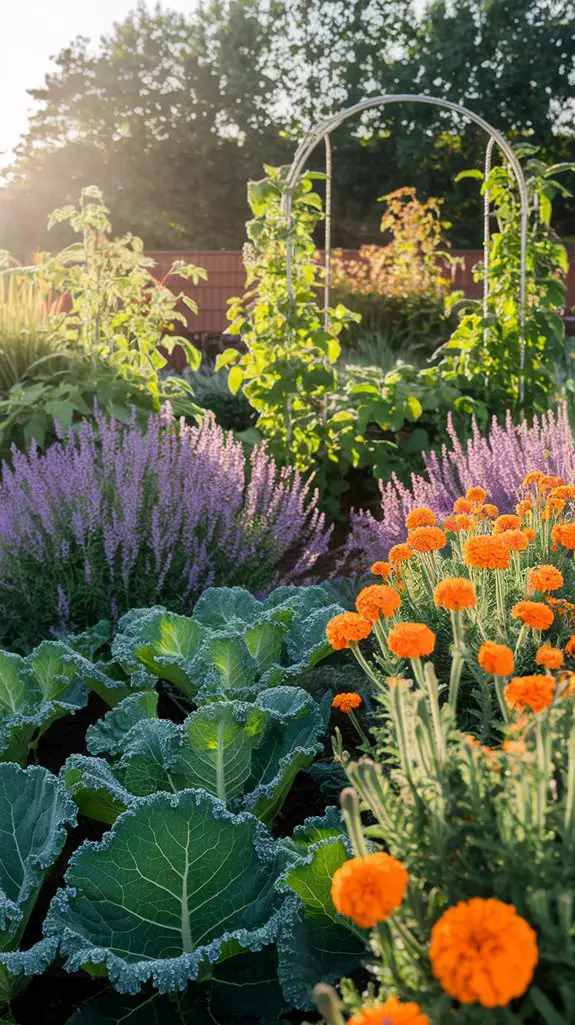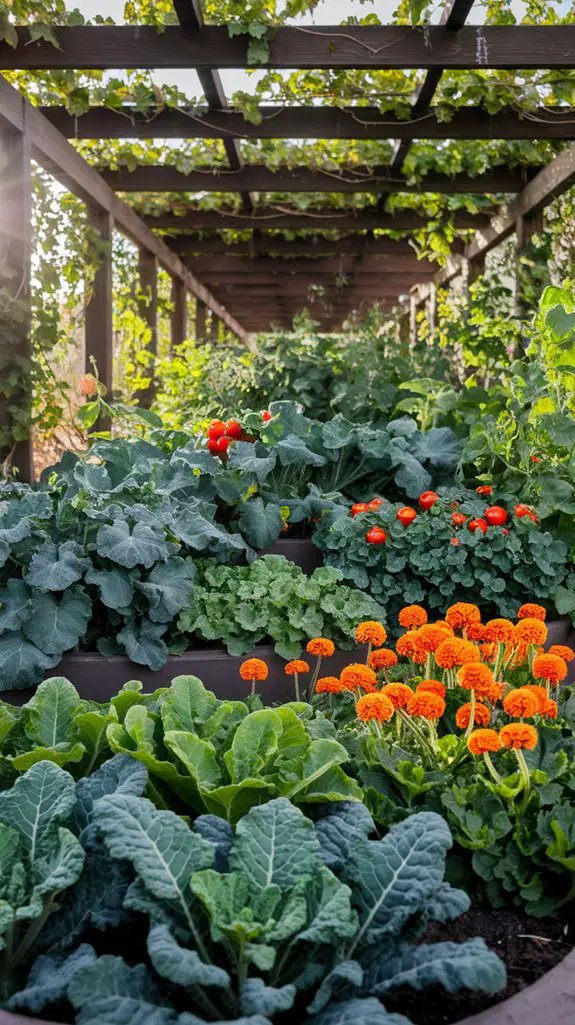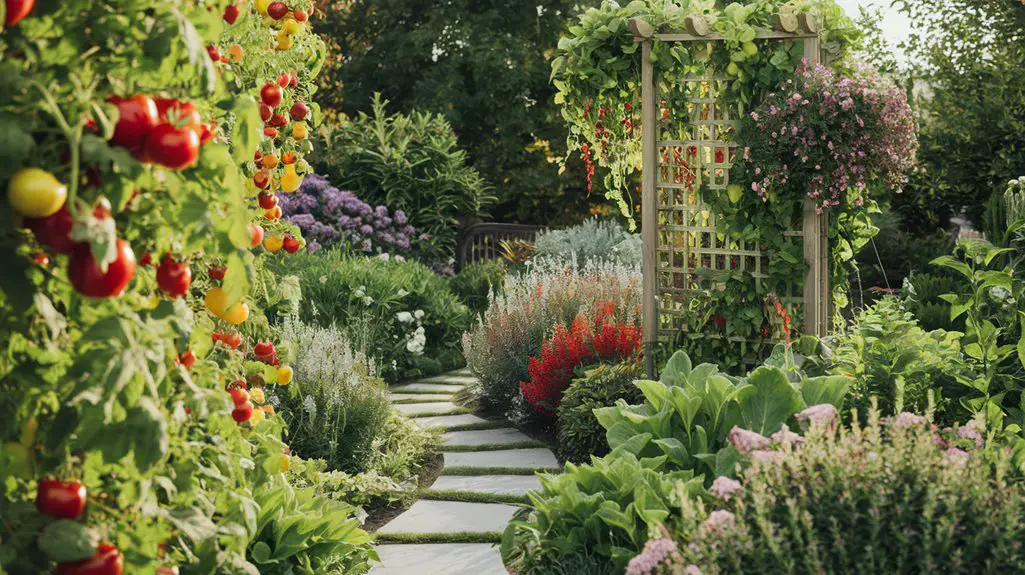You're transforming that underutilized green space into a multi-functional ecosystem that serves both your aesthetic and nutritional needs. Edible landscaping integrates Malus domestica (apple trees) with Lavandula angustifolia (lavender) and Rosmarinus officinalis (rosemary) to create visually compelling layouts while yielding 0.5-2kg of produce per square meter annually. Your yard's microclimate—whether USDA zones 4-9—determines best plant selection and placement. The integration requires initial soil testing (pH 6.0-7.0 ideal) and strategic companion planting to maximize yields.
Benefits of Combining Beauty With Food Production
While traditional landscape design focuses solely on ornamental value, integrating edible plants (Familia Poaceae, Rosaceae, Fabaceae, among others) into your landscape creates a functional ecosystem that yields 2.5-4 kg of produce per square meter annually. This integration provides a 30-40% reduction in grocery expenditure while enhancing biodiversity. You'll maximize solar exposure when you implement vertical growing systems for Cucurbitaceae species, utilizing 40% less horizontal space. Perennial Asparagus officinalis and Fragaria × ananassa establish deep root systems (1-2 m), improving soil structure and reducing irrigation requirements by 25%. The juxtaposition of Thymus vulgaris with Rosa rugosa offers pest management benefits—companion planting decreases aphid populations by 60%. Additionally, you're creating habitat for Apis mellifera and other pollinators, resulting in 35% better fruit set on Malus domestica and Prunus avium specimens. Furthermore, incorporating native plants for wildlife can further enhance your garden's ecological value and support local fauna.
Top Edible Plants That Double as Ornamentals

Several ornamental plants with exceptional aesthetic qualities also provide nutritional benefits.
Consider Vaccinium corymbosum (blueberry) with its spring flowers, summer fruit, and fall foliage reaching 1.8 meters in height.
Rosmarinus officinalis (rosemary) offers evergreen structure and edible, aromatic foliage in USDA zones 8-10.
For vertical interest, train Actinidia deliciosa (kiwi) on trellises, requiring 4.5-6 meters of space for ideal fruit production.
Thymus vulgaris (thyme) creates a 10-15 cm groundcover with culinary and ornamental applications.
Lavandula angustifolia provides both visual appeal and edible flowers containing 0.5-1.5% essential oils.
You'll find Fragaria × ananassa (strawberry) effective as border plants, producing 0.5 kg of fruit per plant annually when spaced 30 cm apart in well-draining soil with pH 5.5-6.5.
Incorporating these plants promotes eco-friendly gardening practices that benefit both the environment and your health.
Designing Your Edible Landscape for Year-Round Harvests

Creating a productive edible landscape requires strategic planning across all seasons to maximize harvest potential.
Develop a planting calendar that orchestrates succession planting of Brassica oleracea varieties in spring and Solanum lycopersicum cultivars during summer months. Incorporate deciduous fruit trees (Malus domestica, Prunus persica) with understory plantings of shade-tolerant Fragaria × ananassa.
- Position perennial herbs like Rosmarinus officinalis and Thymus vulgaris in 0.5m² plots along southern exposures.
- Establish 3-4 distinct garden beds (1.2m x 3m) for crop rotation within 90-day cycles.
- Install Vaccinium corymbosum and Rubus idaeus in 1m diameter mulched circles for July-September harvests.
- Integrate winter-hardy Cichorium intybus and Brassica oleracea var. gemmifera for harvests at temperatures <5°C.
Incorporating edible landscaping ideas can enhance both aesthetics and utility in your garden design.
Water-Saving Strategies for Productive Food Gardens
Efficient water management forms the foundation of sustainable edible landscapes, particularly as climate variability increases.
Implement drip irrigation systems that deliver 1-4 gallons per hour directly to Solanum lycopersicum and Capsicum annuum root zones, reducing water waste by 30-50%.
Apply 3-5 inches of organic mulch—comprised of Pinus strobus needles or Quercus alba leaves—to minimize evaporation and maintain soil moisture at 40-60% capacity. Additionally, using eco-friendly mulch can enhance soil health and promote biodiversity in your garden.
Harvest rainwater via 50-100 gallon catchment systems connected to roof downspouts, providing chlorine-free hydration for Fragaria × ananassa and Rubus idaeus.
Group plants by hydrozones: situate Thymus vulgaris and Salvia officinalis (requiring 0.3-0.5 inches weekly) separately from water-intensive Cucumis sativus (needing 1-2 inches weekly).
Consider installing soil moisture sensors at 6-8 inch depths to optimize irrigation scheduling.
From Lawn to Food Forest: Transition Planning
While conventional lawns consume 30-50 gallons of water per square foot annually, transforming these monocultures into layered food forests can reduce water usage by 45-60% after establishment.
Converting requires systematic implementation of ecological succession principles, mimicking natural forest development.
Begin your conversion with these sequential phases:
- Sheet mulch existing turf with 12-15 cardboard layers (minimum 3mm thickness) overlapped by 15cm to smother Poaceae species.
- Install woody perennials first—*Malus domestica* and *Prunus* species as canopy, *Corylus* and *Sambucus* in the shrub layer.
- Create 45-60cm wide paths using 10cm of wood chip mulch (preferably *Quercus* or *Juglans*).
- Add herbaceous understory progressively—*Fragaria*, *Mentha*, and *Thymus* species provide 85-95% ground cover within 24 months.
This polyculture system establishes Mycorrhizal networks, dramatically improving drought resilience. Additionally, incorporating raised garden beds can further enhance your vegetable yields and optimize garden space.
Maintaining Your Edible Landscape Through the Seasons
Once your edible landscape establishes its foundational layers, seasonal maintenance becomes the key factor determining system productivity and long-term viability. You'll need to implement specific practices aligned with phenological indicators rather than calendar dates.
| Season | Critical Maintenance Tasks |
|---|---|
| Spring | Prune *Malus domestica* specimens (30% crown reduction); apply 5cm compost layer |
| Summer | Irrigate during drought (15L/m² weekly); harvest *Solanum lycopersicum* at 85% ripeness |
| Fall | Collect seeds from *Lactuca sativa*; mulch perennials with 7.5cm leaf litter |
| Winter | Protect *Citrus sinensis* below 4°C; prune dormant *Rubus* species |
| Early Spring | Divide overcrowded *Allium* spp.; direct-sow cool-season annuals at 1.25cm depth |
Monitor soil moisture at 15cm depth and maintain pH between 6.2-6.8 for ideal nutrient availability in your edible ecosystem.
Conclusion
Your edible landscape isn't just aesthetically pleasing—it's a functional ecosystem that'll reduce your ecological footprint by 30-40%. Integrate Malus domestica (apple) trees with Lavandula angustifolia for pest control, maintaining 18-24" spacing between Ocimum basilicum plantings. As ye olde gardeners knew, succession planting of Brassica oleracea varieties guarantees continuous harvests through spring's 45°F soil temperatures into autumn's first frost, maximizing your yard's productivity while minimizing resource inputs.




